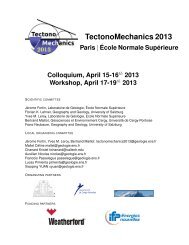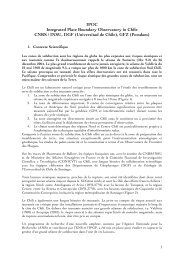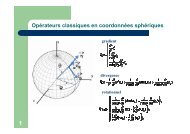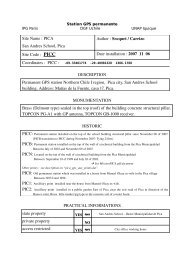PDF file - Laboratoire de Géologie de l'Ecole normale supérieure - Ens
PDF file - Laboratoire de Géologie de l'Ecole normale supérieure - Ens
PDF file - Laboratoire de Géologie de l'Ecole normale supérieure - Ens
You also want an ePaper? Increase the reach of your titles
YUMPU automatically turns print PDFs into web optimized ePapers that Google loves.
MICROBLOCK ROTATIONS IN SULAWESI, INDONESIA<br />
spaced (~14 km apart) faults with shallow locking <strong>de</strong>pths<br />
accommodating a total amount of 30 mm/yr, the<br />
remaining motion being accommodated 50 km to the<br />
east. That refined three dislocation mo<strong>de</strong>l has important<br />
consequences concerning the seismic hazard: the<br />
coexistence of three dislocations with very shallow<br />
locking <strong>de</strong>pths may explain the <strong>de</strong>ficit of paleoseismicity<br />
on the one studied surface trace of the fault. The GPS<br />
inferred slip-rate agrees with the long-term slip-rate<br />
<strong>de</strong>termined from stream and fan offsets [Bellier, et al.,<br />
2001]. The Lawanopo/Matano Fault zone, extending<br />
from the Palu fault toward the south, is probably coupled<br />
in the interseismic period. It is still poorly known which<br />
of these faults is the southern continuation of the Palu<br />
fault. Sulawesi is surroun<strong>de</strong>d by three active trenches.<br />
The East Sulawesi Trench accommodates the motion<br />
between the Banda Sea and the Makassar block. This<br />
trench is affected by periodic earthquakes between which<br />
strain is accumulated above the locked subduction plane.<br />
To explain our measured velocities properly, another<br />
locked fault must be located in the Makassar Strait.<br />
Finally, the Minahassa Trench bounds the island to the<br />
north and accommodates the motion of the North Sula<br />
block relative to the Sunda Plate. We find here a null<br />
coupling for this trench that has generated very large<br />
subduction earthquakes in the recent past [Gomez et al.,<br />
2000]. Hence, this absence of loading can not represent<br />
the regular interseismic behaviour of the trench and is<br />
certainly a transient state maybe due to afterslip<br />
following a recent seismic event [Mazzotti, et al., 2000].<br />
Limitations of the mo<strong>de</strong>l<br />
To fully represent the interseismic <strong>de</strong>formation, the<br />
time series of the sites affected by earthquakes should be<br />
analysed in terms of transient displacements, co-seismic<br />
jumps and post-seismic <strong>de</strong>formation. Beyond its crucial<br />
interest for a better un<strong>de</strong>rstanding of the earthquake<br />
cycle, such mo<strong>de</strong>lling can also allow better <strong>de</strong>termination<br />
of the interseismic velocity required for kinematic<br />
studies. However, constraining coseismic and<br />
postseismic <strong>de</strong>formation requires long and <strong>de</strong>nse<br />
(temporally and spatially) time series (i<strong>de</strong>ally those<br />
provi<strong>de</strong>d by permanent GPS stations) that are still<br />
missing at most sites.<br />
The current mo<strong>de</strong>l explains the data and <strong>de</strong>scribes the<br />
kinematics and the behaviour of the active structures<br />
around Sulawesi. Given the sparseness of the data, the<br />
interseismic coupling on several of the faults should only<br />
be taken as a first approximation. However, the<br />
<strong>de</strong>formation around Palu and Gorontalo faults is<br />
accurately mo<strong>de</strong>lled. Our <strong>de</strong>tailed analysis in the Palu<br />
area revealed several subsurface splays of the fault<br />
unknown prior to this study.<br />
14<br />
Acknowledgements<br />
This work is a continuation of the joint research<br />
activities in SE Asia, which were initiated by the<br />
GEODYSSEA project. Thanks and appreciation are<br />
exten<strong>de</strong>d to all people who have contributed significantly<br />
in expanding the GPS data base on SE Asia. We would<br />
like to thank especially all the staff and stu<strong>de</strong>nts at the<br />
Geo<strong>de</strong>sy <strong>de</strong>partment of the Institut Teknologi Bandung<br />
and the Geodynamics division of the National<br />
Coordination Agency for Surveys and Mapping<br />
(BAKOSURTANAL) in Indonesia for their contribution<br />
to the GPS measurements in Sulawesi. GPS activities in<br />
Indonesia were supported by the Dutch Integrated Solid<br />
Earth Science (ISES) research program, the French<br />
Embassy in Indonesia (Service <strong>de</strong> Coopération et d'Action<br />
Culturelles - SCAC) and the French Ministry of Research<br />
(through the ACI "Observation <strong>de</strong> la Terre" research<br />
program). Finally the authors also wish to thank the Jet<br />
Propulsion Laboratory (JPL) for their support and advice<br />
on using the GIPSY-OASIS GPS software. This paper<br />
benefited from very constructive reviews (A.E., M. Keep,<br />
L. Wallace and an anonymous associate editor). We want<br />
to express special thanks to L. Wallace for her extremely<br />
long, <strong>de</strong>tailed and thorough analysis of our work. The<br />
maps in this paper were produced using the public domain<br />
Generic Mapping Tools (GMT) software [Wessel and<br />
Smith, 1995].<br />
References<br />
Altamimi, Z., et al. (2002), ITRF2000: A new release of<br />
the International Terrestrial Reference frame for earth<br />
science applications, Journal of Geophysical Research-<br />
Solid Earth, 107, art. no.-2214.<br />
Aurelio, M. A. (2000), Shear partitioning in the<br />
Philippines: Constraints from Philippine Fault and<br />
global positioning system data, Island Arc, 9, 584-597.<br />
Barrier, E., et al. (1991), Philippine Fault - a Key for<br />
Philippine Kinematics, Geology, 19, 32-35.<br />
Beaudouin, T., et al. (2003), Present-day stress and<br />
<strong>de</strong>formation fields within the Sulawesi Island area<br />
(Indonesia): geodynamic implications, Bull. Soc. Geol.<br />
Fr., 174, 305-317.<br />
Bellier, O., et al. (2001), High slip rate for a low<br />
seismicity along the Palu-Koro active fault in central<br />
Sulawesi (Indonesia), Terr. Nova, 13, 463-470.<br />
Bellier, O., et al. (2006), Fission track and fault<br />
kinematics analyses for new insight into the Late<br />
Cenozoic tectonic regime changes in West-Central<br />
Sulawesi (Indonesia), Techtonophysics, 413, 201-220.<br />
Blewitt, G., et al. (1988), GPS geo<strong>de</strong>sy with centimeter<br />
accuracy, in Lecture Notes in Earth Sciences, edited by<br />
E. G. a. R. Strauss, Springer-Verlag, New York.






